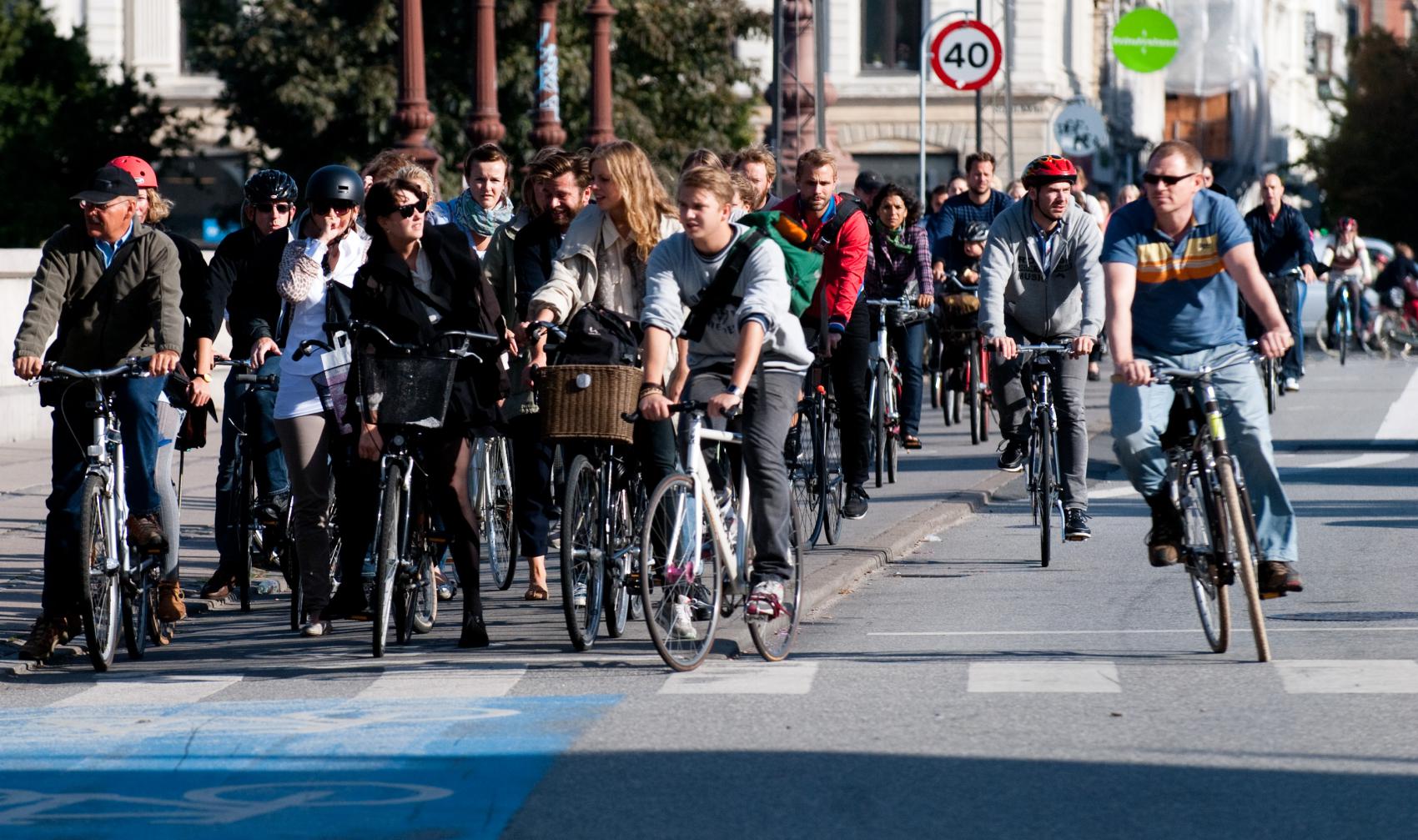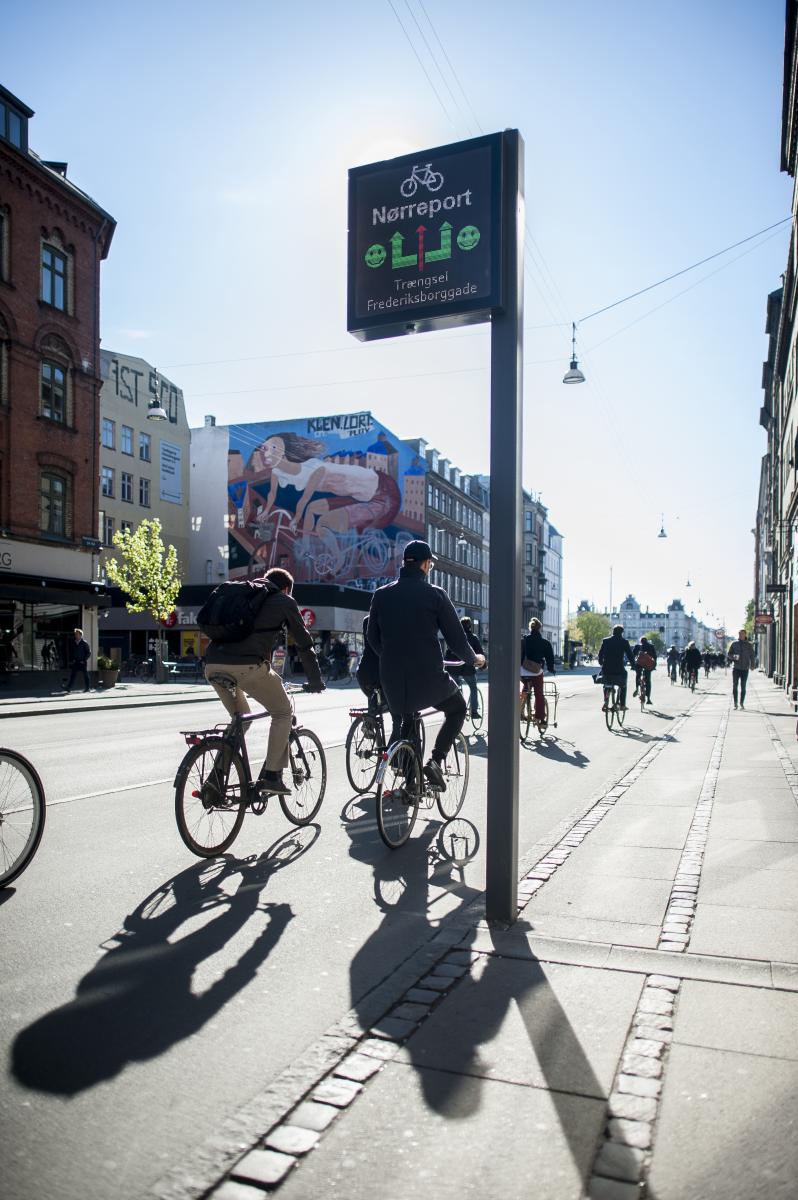
Smarter Cycling Series: City of Copenhagen introduces variable message signs – exclusively for cyclists
As part of our work to help cycling and the bike industry into the world of smart, connected and shared mobility we are working with visionaries and leaders who are setting the tone in this new mobility. We are going to be inviting some of them to share their thoughts and visions with ECF.com in the coming months.
Jos van Vlerken is the ITS Project Manager for the City of Copenhagen. He works towards piloting and implementing technologies that will improve the mobility and access for the citizens of Copenhagen, especially cyclists.
Variable message signs for cyclists in Copenhagen
The City of Copenhagen is constantly developing its cycling infrastructure. Having already an extensive network of cycle lanes- separated from motorized traffic, the time is right to test and implement a layer of digital technologies on top of the physical infrastructure. This digital layer includes technologies for bicycle traffic information services such as variable message signs. In spring 2017, five variable message signs were installed exclusively for cyclists. The signs can display information about congestion on the bike track ahead, as well as travel times, events, road works and more. Most of this information is gathered through sensor equipment and other connected data sources. The signs are to be evaluated based on their capacity to induce behavioural change – like alternative route choice by cyclists – based on the information shown.
History and purpose
Copenhagen’s extensive network of dedicated bike lanes and complementary infrastructure (separate signal heads at intersections, destination and distance signposts, etc.), is the result of 30 years of prioritizing cycling as the transportation mode of the future.

The city of Copenhagen has been successful in achieving a modal shift away from motorized transport towards cycling. The number of trips by bicycle in the inner city exceed those by car, while 63% of the population in Copenhagen prefers the bicycle for commuting to work and education. Furthermore, 30% of all trips with start and/or stop in Copenhagen are made by bicycle. Occasionally, this results in congestion on the bike lanes, while road works or events on central bike corridors can become a nuisance for tens of thousands of people per day.
For this reason, in 2014, through public-private innovation cooperation, the City of Copenhagen together with a group of entrepreneurs and companies conceived the idea of developing variable message signs for cyclists. Variable message signs for traffic information purposes have conventionally been used for motorised traffic on highways for decades. Now it was time to see if the behavioural change effects, which these signs have on motorized vehicles, could be transferred to cyclist traffic.
The primary issue to be solved is congestion. Even though segregated bike tracks are already 3 meters wide some places, with 50 or more cyclists per minute, we still see congestion on the bike tracks. Furthermore, by offering relevant and real time traffic information and route suggestions specifically to cyclists, the idea is to inspire cyclists to use less used tracks whereby the overall cycling capacity of the city infrastructure could be more effectively used.
In an infrastructural and behavioural perspective there is potentially a lot to gain from the signs. The bicycle is a very flexible mode of transportation and usually in Copenhagen one has more route choices on the bike than in motorized vehicles. On the other hand people usually exhibit fixed, routine based behaviour. Sometimes, the cyclists use routes that are less efficient because of habit and lack of knowledge of alternative routes. Infrastructure is changed, traffic signals are coordinated to create “green waves”, new bike lanes are built and existing bike lanes are widened, making other routes than the ones, which are commonly used, more efficient for the cyclist. As behavioural psychologists show, because of habit, these changes are not commonly noticed and the majority of cyclists continue in the same routes as always.
The variable message signs also have the purpose of supporting Copenhagen’s growing cyclists’ community awareness of the impact of biking on the city infrastructure and environment. Besides the practical information regarding congestion, road works and events, this is achieved by showing information on air quality and comparative travel times between cars and bikes, showing that the bicycle is the fastest mode of transportation in peak hours in Copenhagen. In this way, cycling is a more attractive mode of transportation in the City of Copenhagen – not just individually - but also showing how cycling is part of the solution to the challenges of the city as a whole, with regards to for instance traffic safety, lowering pollution and fighting climate change. The variable message signs contribute to cyclists becoming aware of and spreading consciousness of the benefits of cycling in the city.
Last but not least, the variable message sign for cyclists acts as a tool for the City Traffic Managers in achieving the service goals which the city has set for traffic. The City of Copenhagen has set certain specific service goals for all modes of transportation, but especially for cycling. By 2018, the City of Copenhagen will reduce the travel time for cyclists on specific corridors by 10 % and also reduce the amount of stops, especially a nuisance for cyclists, by 10 %. This will make cycling more attractive and will invite an even larger part of the population to use the bike instead of the car.
|
Data and cyclists traffic management
The variable message signs are the first truly variable signs for cyclists in the world. They are not built to solely serve one purpose and can therefore display any relevant information as long as the data is present. For this purpose, as well as for cyclist traffic management, the City of Copenhagen is installing an extensive sensor network for cyclists.
The sensor network does at this moment count cyclists and measure queue length at intersections, and in turn this data drives the indicator of congestion shown on the screen. Traffic data is fed into the City Traffic Management platform MobiMaestro, from which the variable message signs are operated automatically based on scenarios set by the City of Copenhagen. In the near future it will be possible to inform cyclists about air pollution on certain routes and propose alternative routes with less air pollution.
Conclusion
The amounts of cyclists and the political will to advance cycling even further still drives innovation in Copenhagen towards an improved cycling infrastructure. To accommodate the large amount of cyclists in the existing infrastructure Copenhagen has installed variable message signs exclusively for the use in cyclists’ traffic. These signs will be piloted in 2017 and it will be investigated whether the behavioural effects of variable message signs on motorists can be observed in cyclist traffic. If effective, the variable message signs will through information about congestion and other incidents disperse cyclist traffic, thereby using the city’s cyclist infrastructure more efficiently.
Regions:
News category:
Network/Project Involved:
Contact the author
Recent news!
Upcoming events
Contact Us
Avenue des Arts, 7-8
Postal address: Rue de la Charité, 22
1210 Brussels, Belgium











